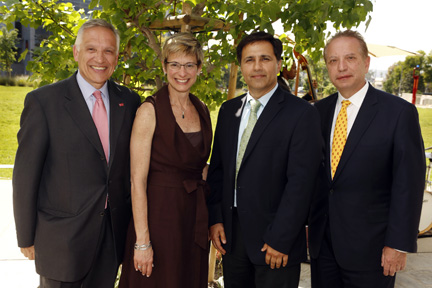
At the April 22 event honoring Mark Humayun are, from left: Viterbi School Dean Yannis C. Yortsos, USC Provost and Senior Vice President for Academic Affairs Elizabeth Garrett, Humayun and Keck School Dean Carmen A. Puliafito. Photo/Steve Cohn
University officials recently honored Mark Humayun, a professor with joint appointments at the Keck School of Medicine of USC and the USC Viterbi School of Engineering, for his groundbreaking work in a retinal prosthesis that was recently approved by the U.S. Food and Drug Administration.
Joining the April 22 celebration for Humayun were Keck School Dean Carmen A. Puliafito, Viterbi School Dean Yannis C. Yortsos and USC Provost and Senior Vice President for Academic Affairs Elizabeth Garrett.
Humayun, the Cornelius J. Pings Chair in Biomedical Sciences and professor of ophthalmology, biomedical engineering, cell and neurobiology, was the principal member of a team that developed the Argus II—an implant that can restore sight to some people blinded by retinitis pigmentosa.
Puliafito called Humayun’s 25-year effort “audacious” and said few thought such a device would be possible.
“Until this moment, there has never been a way of restoring sight to such profoundly impacted individuals,” Puliafito said. “In the long term, we have good reason to believe the Argus will eventually help individuals with age-related macular degeneration, the leading cause of blindness in the industrialized world.”
Garrett thanked Humayun for his “brilliant career.”
“Your scholarship is transforming lives, and your research has inspired new approaches in the fields of ophthalmology and biomedical engineering, among many others,” she said.
The Argus II has been implanted in 30 patients in a clinical trial that began in 2007. Humayun performed many of the surgeries. The system uses a camera mounted on special glasses that send signals to a receiver implanted inside the eye. After traveling through the optic nerve, the signals reach the brain, where they are interpreted visually.
“It’s an incredible contribution you’ve made, one that will enable lives to be lived in such a better way,” Puliafito said.
As the Argus II retinal implant is refined, it will be part of the USC Institute of Biomedical Therapeutics. The new interdisciplinary institute will bring together scientists, engineers and clinicians to develop bioelectronic solutions for people impacted by conditions including traumatic brain injury, stroke and debilitating eye diseases.

